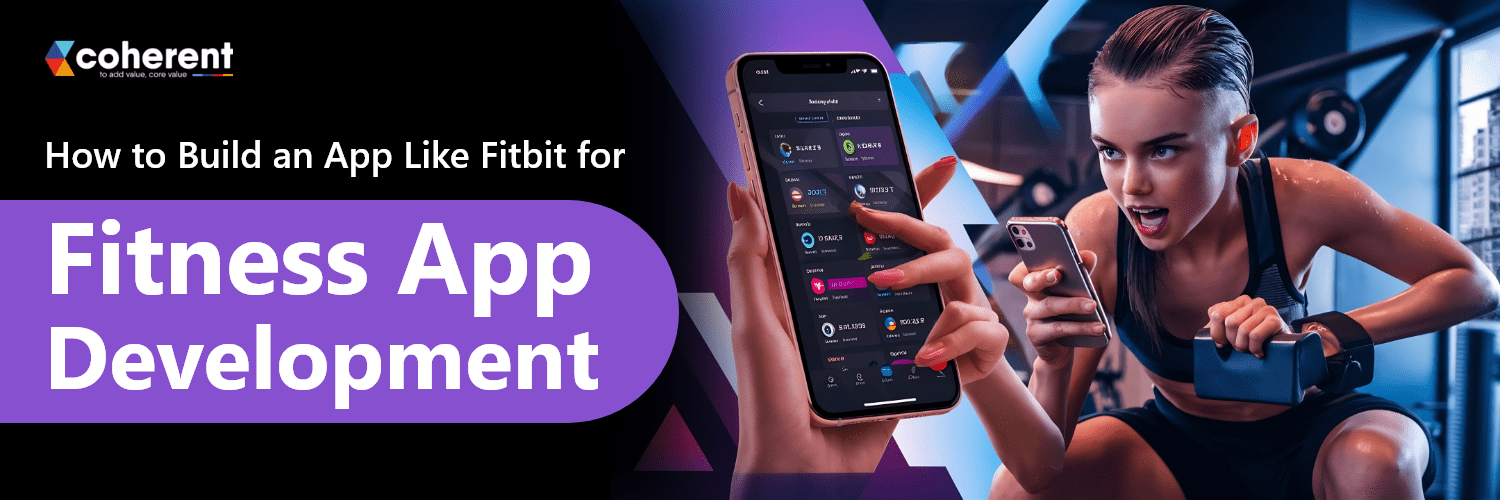How to Build An App Like Fitbit for Fitness App Development?

The 21st century has seen a remarkable shift toward healthier and eco-friendly lifestyles. As people embrace fitness and wellness more than ever, the demand for mobile fitness apps is skyrocketing. From workout tracking and nutrition guidance to yoga and meditation, these apps empower users to achieve their health goals conveniently from home or on the go.
For startups and developers, investing in fitness app development is not just a smart business move—it’s a chance to make a meaningful impact on people’s lives. Whether you’re planning an iOS, Android, or cross-platform app, understanding market trends, essential features, and user needs is key to creating a successful product that stands out in a competitive landscape.
What is a Health and Fitness Application?
A health and fitness application helps users track and improve their overall wellness, from daily step counts to heart rate, calorie burn, hydration, and sleep cycles. These apps have evolved far beyond simple pedometers, now integrating AI, wearable connectivity, and cloud data to deliver personalized insights.
Modern fitness apps like Fitbit collect health data through wearable devices, analyze patterns, and help users make informed lifestyle changes. The key to success lies in being accurate, user-friendly, and motivational, so users can build lasting fitness habits.
Read More: Fitness App Development – A Comprehensive Guide
Overview of Fitbit
When Fitbit launched in 2009, it changed the game for fitness tracking. The first model focused solely on step counts and calorie tracking, offering a simple and intuitive experience. Over the years, Fitbit added new features like heart-rate monitoring, sleep tracking, stress management, and personalized insights.
After Google’s 2021 acquisition, Fitbit became faster, smarter, and more connected, especially for Android users. Yet, its biggest strength remained the same: simplicity. Gamified motivators such as badges, streaks, and weekly challenges keep users engaged and consistent.
How to Develop A Fitness App Like Fitbit?
Creating a fitness app like Fitbit isn’t just about coding; it’s about building something people want to use daily. Let’s break down the development process.
Step 1: Get the Basics Right
Start with a strong foundation. Make sure core functions like step tracking, workout logging, and heart-rate monitoring work flawlessly. Focus on:
-
Smooth and accurate performance
-
Clean, fast-loading dashboards
-
Optional features like yoga or HIIT tracking
-
Smart notifications and motivational reminders
-
Integration with Apple Health and Google Fit
Step 2: Plan Your Monetization Model
After years of experience as a top mobile app development company in the USA, we’ve seen that monetization depends on your audience:
-
Freemium Model: Free basic version, with paid insights or training plans.
-
Subscription Model: Monthly or annual membership with exclusive features.
-
In-App Purchases: Sell digital workout packs, recipes, or merchandise.
-
Brand Collaborations: Partner with fitness brands or nutrition services.
Step 3: Work with an Expert Development Team
Building in the health tech space requires more than coding skills. You’ll need developers familiar with:
Data security (HIPAA, GDPR)
Backend infrastructure for scalability
Wearable API integrations
Real-time sync and performance optimization
At Coherent Lab, our team ensures your fitness app is secure, scalable, and designed for long-term growth.
Step 4: Prioritize Design and Accessibility
If users find your app confusing or cluttered, they’ll uninstall it fast. Focus on:
-
Simple navigation and quick access to key stats
-
Visually appealing charts and progress bars
-
Dark mode and color-coded UI
-
Accessibility (voice commands, large text, readable fonts)
Coherent Lab’s UX team has designed health and fitness apps for over a decade, making sure every screen not only looks good but feels right.
Step 5: Test Intensively Before Launch
Bugs and syncing issues can destroy trust. Before launch, conduct:
-
Manual & automated testing for all devices
-
Real-time performance monitoring
-
Security and privacy testing
-
User feedback sessions
Work with a Development Team That Gets It
Building an app in the health sector isn't just about coding. For that app to succeed, people will really have to like using it. Take Fitbit as a fitness app example; it works so well. It takes planning, teamwork and real know-how about fitness and health. When you have an experienced team, they help make sure your app can grow, stay secure, and handle real challenges. They deal with things like setting up the backend, linking different systems and keeping user info safe.
Start with a discovery phase
Sketch out what matters. Who you're building for, what the MVP looks like vs. future upgrades, data privacy (HIPAA, GDPR if needed), what platforms:- iOS, Android, maybe both? Which APIs you'll need (for wearables, analytics, etc.).
That's when you'll need the support of an expert team to assist you.
At Coherent Lab, the best health and fitness app development company in the USA, we’ve helped health-focused startups build MVPs and scale them without burning through time or budget.
Design Can’t Be an Afterthought
People will not use the app if your app feels too complex to use. A clean interface, quick access to key stats, color-coded charts and little touches like dark mode. Truly, they go a long way.
Also, don't forget accessibility: voice support, larger tap targets, and readable fonts.
Our team, at Coherent Lab, the best fitness app development agency in the USA, has done UX for health, sports and wellness apps for over a decade. We focus on making screens not just look good, but actually useful.
Testing Should Be Intense
Bugs damage credibility faster than missing features ever could. Core tasks like tracking, syncing, and reminders need to work every single time, and without delay. If readings feel wrong, users will notice and leave. Privacy belongs in that same priority list. Encrypt data from day one and explain why permissions are needed.
At Coherent Lab, the top mobile app development company in the USA, we combine hands-on checks with automation to find problems early. The real win isn’t mimicking Fitbit. Rather, it’s creating something people rely on every day.
Cost to Develop an App Like Fitbit
Discover the estimated cost to develop an app like Fitbit, including key features, technologies, and factors influencing pricing for fitness tracking, health monitoring, and real-time activity insights.
-
Basic Fitness Tracker MVP: $30,000 – $50,000
-
Full-Feature Fitbit-Like App: $60,000 – $120,000+
-
Annual Maintenance & Updates: 15–30% of development cost
Key Takeaways
-
Define your target audience and fitness goals clearly.
-
Integrate real-time activity, heart rate, and sleep tracking features.
-
Use AI and data analytics for personalized insights.
-
Ensure seamless integration with wearables and IoT devices.
-
Focus on an intuitive, user-friendly UI/UX design.
-
Partner with an experienced fitness app development company.
Also Read: Why Do You Need Fantasy Sports App Development?
Conclusion
Alright, so here’s the thing. Do you want to develop an application like fitbit? It’s... a lot. Not just coding. There’s planning, design that makes sense, syncing with wearables, and figuring out how people will even use it day to day. And yeah, monetization can’t skip that part.
Honestly, every project that we, at Coherent Lab, the best iOS app development company in USA, have been part of, it’s a bit different. Some folks come in with a full roadmap. Others just have an idea and a few notes. Either way, it’s always about balance:- building enough to launch, without overcomplicating stuff too early.
We've seen what works, and what really doesn’t. You learn over time. Especially in health and fitness tech, where things move fast but users expect things to work.
So, yeah. If you're building in this space, just know there are ways to do it smartly without burning through your budget. It’s doable. You just need a team that’s been there before, like Coherent Lab, the best fitness app development agency in the USA can be your best bet. Connect with us and let’s handle the rest as well.
Frequently Asked Questions (FAQs)
Q1.How much does it cost to develop an app like Fitbit?
Ans. The cost to develop an app like Fitbit typically ranges between $30,000 $150,000, depending on features, platform (iOS, Android, or both), UI/UX design, and development team location.
Q2. What features should a fitness tracking app like Fitbit include
A Fitbit-like app should include real-time activity tracking, heart rate monitoring, sleep analysis, step counter, goal setting, calorie tracking, and social sharing features for maximum user engagement.
Q3.How long does it take to build an app like Fitbit?
On average, it takes around 4 to 8 months to develop a fitness app like Fitbit, depending on the complexity, tech stack, and number of integrated features.
Q4. Which technology stack is best for building a fitness app?
Developers commonly use React Native or Flutter for cross-platform apps, along with Python, Node.js, or Java for backend, and Google Fit / Apple HealthKit APIs for fitness data integration.
Q5. How do fitness apps like Fitbit make money?
Fitbit-style apps generate revenue through subscription plans, premium features, in-app purchases, ads, and partnerships with fitness brands or healthcare companies.


 +91 774-202-1725
+91 774-202-1725
 +1 (945) 3387904
+1 (945) 3387904
 business@coherentlab.com
business@coherentlab.com +49 15223341304
+49 15223341304 UK
UK

